- Lodgefellowship@gmail.com
- Ahemdabad
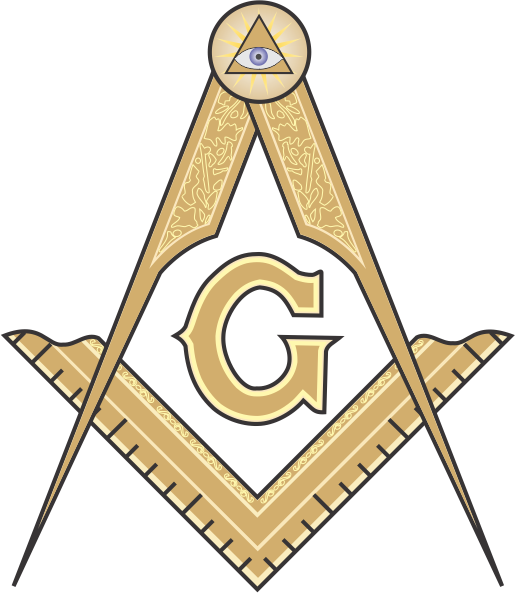
Free Masonry
Symbolism
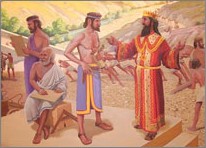
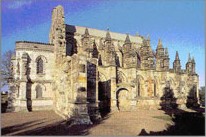
Dialectics of Masonic symbolism: The classical definition of Freemasonry is “A peculiar system of morality veiled in allegory and illustrated with symbols” 5. A good starting point in understanding the alloying elements cont<;lined in masonic ritual is to distinguish and discriminate between “allegory” and “symbolism”. The definition of allegory is “a figurative representation in which something else is intended to what is actually exhibited”. This is typified by our masonic ceremonies, as they have two distinct and different meanings; an “exoteric” or the immediately obvious, and an “esoteric” or the mystical meaning. As apparent in the definition itself the veil that covers the allegory has to be parted by the masonic student and the hidden meaning of the allegory discovered for himself. A parallel can be readily drawn to lifting the veil of “Maya”, that envelopes, the Atman, as per the Hindu scriptures.
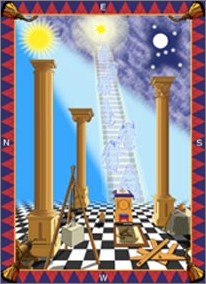
Symbol on the other hand is defined as “something that stands for, represents or recalls something else not by exact resemblance but by suggestions or associations in thought, especially an object that represents something abstract as an idea, quality or condition” 4. Far from its origins, symbolism and symbols has a wide and differentiated usage and application in diverse fields ranging from mathematics, geometry, linguistics, philosophy, anthropology, to art, literary criticism, theatre, religion and most importantly in daily life. As Freemasons we ever recognize the profuse, effective and pervasive usage of symbols in our rituals and literature.
Flumini 6, has described a symbol as “any element that refers to another independently of the methods by which the other is represented”. The pre-requisite of a symbol is that “it must render the presence of the represented in an immediately effective manner”, and must not be “conventional”. The distinguishing character of a symbol is that it must instantly “communicate” or immediately strike a chord in the “mind and heart” of the reader, beholder or the perceiver, that the “representative himself takes part in the represented reality” thus endowing it with an exceptional sensitivity. Nowhere but in our Masonic ritual is such symbolical and allegorical application seen in action with such grace, fluidity and felicity.
Masonic symbolism as contained in our rituals, induces in the candidate an instant rapport and develops a magical bond between the reality of our daily life and experience from the represented symbol. Coleridge has described this as the “bond between the representative and the represented”. Goethe 6 has beautifully captured its essence thus: “….the mission of the allegory and of the symbol is to connect the peculiar to the universaL…. a vivid and instantaneous revelation of the inscrutable…” The distinction between allegory and symbolism is subtle, but indeed different; allegory through the concept searches for something outside itself; symbol instead finds it immediately demonstrating nothing more than itself. It is just through its self evident reason of existence that it carries within itself the essence of the universal”.
The Didactics of Masonic Symbolism:
Masonry symbolically speaks of three greater and three lesser lights and thereby it acknowledges the existence of a hierarchy and relevance in the moral truths it contains. No doubt, they all lead to the grand and the only truth, as the Vedas declare “Ekam Sath, Viprah Bahuda Vadanti” – the truth is only one, but it is spoken of differently and so it is with masonic symbols. It is my speculative thesis that the whole pantheon of masonic symbols can be reduced for an analytical masonic study into three classes of greater symbolisms and three lesser symbolisms. The three greater are the symbolism of death and immortality exemplified by the Hiramic legend, the acceptance of Omnific Supreme being, and the profound injunction – Know Thy Self. The lesser lights are three and oontained in the symbolism of the lodge – in its form, its ornaments, furniture and jewels etc, the symbolism of the rituals – such as in the knocks, the perambulation and the like, the sym~olism of the nobility of labour and refreshment, in constructing our spiritual temple – thus our destiny and that of humanity. These, the lesser lights are easy of comprehension, lie open in the lodge for the brethren to moralise upon, and many excellent treatises are readily available and will not be dealt with in this essay.Cedasad boddhum prah Sarirasya Visrasah
Tatah Sargesu lokeshu Sariratvaya kalpate”
Raise us, Great Master till we are made,
One with Thee, in the unspeakable
Glory of Thy Presence in the East.
So Mote It Be.
1. Sanderson. M. Maj: An examination of the Masonic ritual – First degree.
2. Buck. J.D: As cited in Steimetz.G in ref. 3
3. Steinmetz. G: Freemasonry: Its hidden meaning.
4. Mackey. A. G.: The symbolism of Freemasonry.
5. Craft Ritual: Published by the Grand Lodge of India .
6. Flumini. M: Theories of allegory & symbolism. (From Pietre-Stones Review of Freemasonry – Website )
7. Ward. J. S.M: The Master Masons Hand book.
8. Pike. A: Morals & Dogma
9. Zeldis.L: Marcus Aurelius and Vedanta
The Square
The Sacred Volumes lie open upon the Altar of Masonry, and upon them lie the Square and Compasses. They are the three Great Lights of the Lodge, at once its Divine warrant and its chief working tools. They are symbols of Revelation, Righteousness, and Redemption, teaching us that by walking in the light of Truth and obeying the law of Right, the Divine in man wins victory over the earthly.Let us separate the Square from the Compasses and study it alone, the better to see it’s further meaning and use. It is a small, plain Square, unmarked and with legs of equal length, a simple try-square used for testing the accuracy of angles, and the precision with which stones are cut. Since the try-square was used to prove that angles were right, it naturally became an emblem of accuracy, integrity, rightness. As stones are cut to fit into a building, so our acts and thoughts are built together into a structure of Character, badly or firmly, and must be tested by a moral standard of which the simple try-square is a symbol.
“Matruvat pardarani, pardravyasch loshthvat;
Atmanam sarvabhuteshu, yah pashyati, sah pashyati”
or what your task may be
One duty there remains for you
, One duty stands for me.
Be you a doctor skilled and wise,
Or do your work for Wage,
A laborer upon the street,
An artist on the stage;
One glory still awaits for you.
one honor that is fair,
To have men say as you pass by:
“That Fellow’s on the square.”
Ah, here’s a phrase that stands for much,
Tis good old English, too;
It means that men have confidence
In everything you do.
It means that what you have you’ve earned,
And that you’ve done your best
And when you go to sleep at night
Untroubled you may rest.
It means that conscience is your guide,
And honor is your care;
There is no greater praise than this:
“That fellow’s on the square.”
And when I die I would not wish
A lengthy epitaph;
I do not want a headstone large,
Carved with fulsome chaff.
Pick out no single deed of mine,
If such a deed there be,
To ‘grave upon my monument,
For those who come to see.
Just this one phrase of all I choose,
To show my life was fair:
“Here sleepeth now a fellow who
was always on the square.”
The Compasses
In our study of the Square we saw that it is nearly always linked with the Compasses, and these old emblems, joined with the Sacred Volumes, are the Great Lights of the Craft. If the lodge is an “oblong square” and built upon the Square (as the earth was thought to be in olden time), Over it arches the Sky, which is a circle. Thus Earth and Heaven are brought together in the lodge – the earth where man goes forth to his labor, and the heaven to which he aspires. In other words, the light of Revelation and the law of Nature are like to two points of the Compasses within which our life is set under a canopy of Sun and Stars.
No symbolism can be more simple, more profound, more universal, and it becomes more wonderful the longer one ponders it. The principles of Freemasonry are as wide as the world, as high as the sky. Nature and Revelation blend in its teaching; its morality is rooted in the order of the world, and its roof is the blue vault above. The lodge is always open to the sky, whence come those influences, which exalt and ennoble the life of man. Of the heavenly side of Masonry the Compasses are the symbol, and they are perhaps the most spiritual of our working tools.
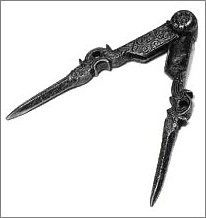
As has been said, the Square and Compasses are nearly always together, and that is true as far back as we can go. In the sixth book of the philosophy of Mencius, in China , we find these words: “A Master Mason, in teaching Apprentices, makes use of the compasses and the square. Ye who are engaged in the pursuit of wisdom must also make use of the compass and the square.” Note the order of the words: the Compass has first place, as it should have to a Master Mason. In the oldest classic of China, THE BOOK OF HISTORY, dating back two thousand years before our era, we find the Compasses employed without the Square: “Ye officers of the Government, apply the Compasses.” Even in that far off time these symbols had the same meaning they have for us today, and they seem to have been interpreted in the same way.
The Level
The Level, so the newly made Mason is taught, is for the purpose of proving horizontals. An English writer finds a lesson in the structure of the Level, in the fact that we know that a surface is level when the fluid is poised and at rest. From this use of the Level he bids us seek to attain a peaceful, balanced poise of mind, undisturbed by the passions which upset and sway us one way or the other. It is a counsel of perfection, he admits, but he insists that one of the best services of Masonry is to keep before us high ideals, and, what is more, a constantly receding ideal, otherwise we should tire of it.The Plumb
Since Freemasonry is a peculiar system of morality veiled in allegory and expressed in symbols, it but necessarily follows that all our teachings are through symbolic means. Most symbols selected in educating masons in morality and in being of service to mankind are taken from real Masonic tools. The level and plumb rule too are such symbols.stood upon a wall made by a plumb-line, with a
plumb-line in His hand. And the Lord said unto
me, ‘Amos, what seest thou? ‘ And I said, ‘A
plumb-line.’ Then said the Lord, ‘Behold, I
will set a plumb-line in the midst of my
people of Israel : I will not again pass them
by any more.”
The Lambskin Apron
In Masonic symbolism the Lambskin Apron holds precedence. It is the initial gift of Freemasonry to a candidate. Above all other symbols, the Lambskin Apron is the distinguishing badge of a Mason. It is celebrated in poetry and prose and has been the subject of much fanciful speculation. Some Masonic writers have contended that initiation is analogous to birth, or our advent from prenatal darkness into the light of human fellowship, moral truth and spiritual faith. Much ancient lore has been adduced in an effort to show that the Lambskin Apron typifies regeneration, or a new life. By many, it has been regarded as a great religious symbol. In our present conception there are three parts of man, body, soul and spirit; what the body is to the soul, the soul is to the spirit, namely, a house or habitation, but in oriental thought there were seven parts of man, four earthly and three heavenly, four physical and three spiritual. The four sides of the square symbolized the four physical and the three sides of the flap, or triangle, symbolized the three spiritual parts of man. The apes of the triangle or point of the flap stood for the seventh part of man which was called Atma and which means the eternal spark, the divine flame, the indestructible spirit of the living God in every human being. In this aspect it means thatAt the life of anyone;
God is under every man,
God is part of every man.
The Apron when correctly understood is the pledge of a clean life, the testimony that a candidate means to live pure, speak true, right wrong, and reverence conscience as king. When we turn to the Ritual for its interpretation, we find the Apron to be an inheritance from the past, and so, in the forth place, it is a badge of antiquity, ” more ancient than the Golden Fleece and Roman Eagle. ” The most specific way of conveying thought and expressing truth is by comparison. It is difficult to comprehend an idea unless we can correlate and compare it with something already known. the Order of Golden Fleece here referred to was founded in the year 1492 by Philip, Duke of Burgundy; the Roman Eagle became Rome’s ensign of imperial power about one century before the Christian era, while the Apron has come down to us from the very sunrise of time. “Hebrew Prophets often wore Aprons,” they were used in the ancient mysteries of India and Egypt, they were used by early Chinese secret societies, by the Jewish religious sect called Essenes, they were employed as emblems by the Incas of Peru, the Aztecs of Mexico, and the prehistoric races of the American continent.
Masonic Tracing Boards
Masonic Tracing Boards are training devices. In the earliest days of speculative Masonry, the Master would sketch designs on the floor of the Lodge using chalk. Then he would talk about the drawing during the meeting. During the course of the 18th century, the drawings were transferred to “Tracing Boards” which are pictures, one per Degree that encapsulates the symbols of each of the Degrees.
Tracing boards seek not only to educate the members of the teachings of Freemasonry as a system of morality but also explain in part the history and mystery of the craft. While the tracing board for the first degree educates one about the virtues celebrated in Freemasonry, it also explains the various stages attained by masons as they progress in the craft.
The tracing board for the second degree describes the temple and through the same seeks to explain the tenets of the craft.
The third degree tracing board is probably the most profound of all as it deals with that one subject that each one of us is vary of. It deals with the concept of death and coupled with the ritual of third degree describes a concept central to Freemasonry.
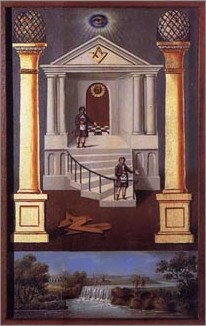
- Home
- About Us
- Donation
- Blog
- Contact Us